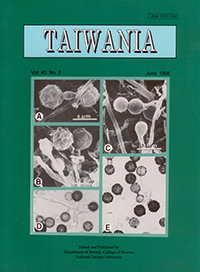Research Paper
Plant in Response to Copper Toxicity
Ching-Chien Tsay, Li-Wen Wang and Yung-Reui Chen
Published on: June 1995
Page: 173 - 181
DOI: 10.6165/tai.1995.40.173
Abstract
Ten-day old seedlings germinated from seeds of tested plants obtained from commercial sources and Cu-polluted open field were transferred to a Hoagland's solution containing various concentration of copper. Young plants grew better in Hoagland's solution containing 2 μM copper than that of plain one. Among eighteen tested plants, Miscanthus floridulus and Dianthus barbatus were more tolerant to excess copper. Most Cu-treated plant showed growth retardation in root and shoot, and sometimes leaf chlorosis. Structural changes of cells induced by copper toxicity were found in extracellular matrix and intracellular organelles. Breakage of membrane systems frequently appeared in various tissues of susceptable plants. Chloroplast abnormalities occurred in leaf tissues. Electron-dense granules were found in cell wall, vacuoles, chloroplast and cytoplasm. Acid phosphatase and peroxidase are verified to be the potential markers for the plants in response to coppper stress.
中文摘要
污染現場採集所得及買自種子店的種子萌發兩週後植株,經移栽在含不同銅溶液的培養液中兩週後,觀察植物的外表形態及進行比較。長在 2 μM銅濃度的植株比長在其他各種濃度者為佳,甚至比對照組好。而在檢驗的十八種植物中以五節芒 (Miscanthus floridulus) 及西洋石竹 (Dianthus barbatus) 抗性較高。一般銅的毒害造成根與莖部的生長受抑制,時間一長也會產生葉子黃化。致害在構造上而言,造成細胞外質質深、胞器的變異及膜系滲漏。電子密度高的顆粒或沉澱往往出現在細胞壁、細胞質、葉綠體及液胞上。酸性磷酸酵素及過氧化酵素在銅毒害的情況下變異顯著,可當生化指標。
Keyword: Copper, toxicity, structure, peroxidase, acid phosphatase, superoxidase, dismutase, isozymes. 銅,毒害,構造,過氧化酵素,酸性磷酸酵素,同功酵素。


